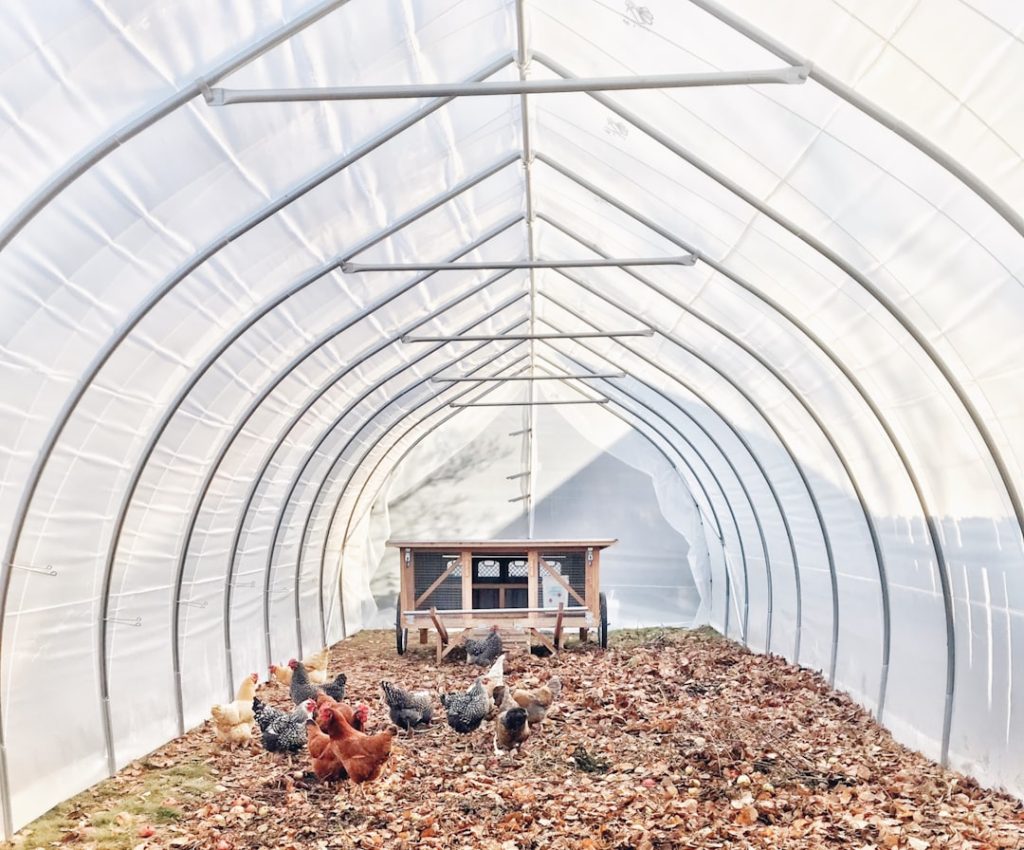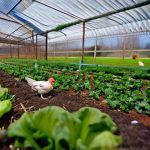Maintaining dry conditions for chickens is essential for their health and productivity. Excessive moisture can lead to various health problems, including respiratory issues, fungal infections, and frostbite. Damp environments also attract pests like mites and flies, which can further compromise chicken health.
By ensuring a dry habitat, poultry keepers can prevent these problems and promote overall flock well-being. Wet conditions negatively impact egg production and quality. Chickens exposed to damp environments may experience stress, which can reduce their laying capacity.
Additionally, wet bedding often results in dirty eggs, making them less appealing and potentially unsanitary. Keeping chickens dry helps maintain optimal egg production and ensures clean, safe eggs for consumption. Understanding and implementing proper moisture control in chicken coops is crucial for maintaining flock health and productivity.
This knowledge enables poultry keepers to create an environment that supports the well-being of their chickens and maximizes egg production.
Table of Contents
- 1 Creating a suitable indoor environment for chickens
- 2 Providing proper ventilation and air circulation
- 3 Using absorbent bedding materials
- 4 Regular cleaning and maintenance of the chicken coop
- 5 Managing moisture levels in the coop
- 6 Monitoring the health and behavior of chickens
- 7 FAQs
- 7.1 What are the benefits of keeping chickens dry while inside the house?
- 7.2 How can I keep chickens dry while inside the house?
- 7.3 What type of bedding should I use to keep chickens dry inside the house?
- 7.4 How often should I clean the coop to keep chickens dry inside the house?
- 7.5 What are some common mistakes to avoid when trying to keep chickens dry inside the house?
Key Takeaways
- Keeping chickens dry is crucial for their health and well-being
- A suitable indoor environment for chickens includes providing adequate space and protection from the elements
- Proper ventilation and air circulation are essential to prevent moisture buildup and maintain a healthy coop environment
- Using absorbent bedding materials such as straw or wood shavings can help keep the coop dry and comfortable for chickens
- Regular cleaning and maintenance of the chicken coop is necessary to prevent moisture-related issues and maintain a clean living space for the chickens
Creating a suitable indoor environment for chickens
Designing a Comfortable Coop
A well-designed chicken coop is crucial for keeping chickens dry and healthy. The coop should be well-ventilated, insulated, and free from drafts to provide a comfortable living space for the birds. Moreover, the coop should be spacious enough to accommodate the number of chickens in the flock, allowing them to move around freely without overcrowding.
Providing Essential Amenities
Providing perches and nesting boxes will give the chickens a sense of security and encourage natural behaviors. Furthermore, it’s essential to ensure that the coop is equipped with proper lighting to maintain a consistent day-night cycle for the chickens. This will help regulate their behavior and egg-laying patterns.
Maintaining Overall Health and Well-being
In addition to a comfortable coop, providing access to clean water and a balanced diet will contribute to the overall health and well-being of the chickens. By creating a suitable indoor environment for chickens, you can help ensure that they remain dry, comfortable, and productive.
Providing proper ventilation and air circulation

Proper ventilation and air circulation are essential for maintaining a dry and healthy environment for chickens. Good ventilation helps remove excess moisture, ammonia, and other airborne pollutants from the coop, which can contribute to respiratory issues in chickens. Additionally, adequate air circulation helps regulate temperature and prevent the buildup of humidity, which can lead to damp conditions.
To provide proper ventilation, the coop should be equipped with windows, vents, or fans to allow fresh air to enter and stale air to exit. It’s important to ensure that these openings are positioned to prevent drafts while still allowing for adequate airflow. Additionally, maintaining proper air circulation within the coop can be achieved by arranging the layout of the coop to allow for natural airflow and avoiding overcrowding of chickens.
By providing proper ventilation and air circulation in the chicken coop, you can help maintain a dry and healthy environment for the birds, reducing the risk of respiratory issues and other health problems associated with damp conditions.
Using absorbent bedding materials
Using absorbent bedding materials is essential for keeping chickens dry and comfortable. Bedding materials such as straw, wood shavings, or shredded paper can help absorb moisture from droppings and spills, preventing damp conditions in the coop. Additionally, these materials provide insulation and cushioning for the chickens, creating a comfortable resting area.
It’s important to regularly monitor the bedding and replace it as needed to maintain cleanliness and dryness in the coop. Wet or soiled bedding should be promptly removed and replaced with fresh material to prevent the buildup of moisture and odors. By using absorbent bedding materials and maintaining cleanliness in the coop, you can help ensure that the chickens have a dry and comfortable living environment.
Regular cleaning and maintenance of the chicken coop
Regular cleaning and maintenance of the chicken coop are essential for keeping the environment dry and healthy for the birds. Cleaning the coop involves removing soiled bedding, droppings, and spilled feed regularly to prevent the buildup of moisture and odors. Additionally, cleaning and disinfecting the coop periodically can help control bacteria, parasites, and other pathogens that can compromise the health of the chickens.
It’s important to pay attention to all areas of the coop, including perches, nesting boxes, feeders, and waterers, to ensure that they are clean and free from contamination. Regular maintenance tasks such as repairing leaks, sealing cracks, and replacing worn-out materials will also contribute to maintaining a dry and comfortable environment for the chickens. By implementing regular cleaning and maintenance practices in the chicken coop, you can help prevent damp conditions and ensure that the birds remain healthy and productive.
Managing moisture levels in the coop

Maintaining a healthy environment for your chickens is crucial, and managing moisture levels in the coop is a vital aspect of this.
Monitoring Humidity Levels
Monitoring humidity levels with a hygrometer can help you assess whether the coop is too humid. If humidity levels are high, it’s important to take steps to reduce moisture buildup by improving ventilation, using absorbent bedding materials, and maintaining cleanliness in the coop.
Addressing Water Leaks and Spills
Additionally, managing moisture levels also involves addressing any sources of water leaks or spills that can contribute to dampness in the coop. Ensuring that waterers are properly maintained and do not leak will help prevent excess moisture from accumulating in the environment.
Creating a Healthy Living Space
By actively managing moisture levels in the coop, you can help create a dry and healthy living space for the chickens, reducing the risk of respiratory issues, fungal infections, and other health problems associated with damp conditions.
Monitoring the health and behavior of chickens
Monitoring the health and behavior of chickens is essential for identifying any signs of stress or illness that may be related to damp conditions in the coop. Observing the chickens regularly for changes in behavior, appetite, or egg production can help you detect any issues early on. Additionally, conducting regular health checks on the chickens, including examining their eyes, comb, wattles, feet, and feathers, can help identify any signs of illness or injury that may be related to damp conditions.
It’s important to consult with a veterinarian if you notice any concerning symptoms or changes in the behavior of the chickens. By monitoring the health and behavior of chickens closely, you can take proactive measures to address any issues related to damp conditions in the coop and ensure that the birds remain healthy and thriving.
If you’re looking for tips on how to keep chickens dry while inside the house, you might also be interested in learning about the best location to put a chicken coop. Check out this article for helpful advice on finding the perfect spot for your chickens’ home.
FAQs
What are the benefits of keeping chickens dry while inside the house?
Keeping chickens dry while inside the house helps to prevent health issues such as respiratory infections and feather mites. It also helps to maintain a clean and comfortable living environment for the chickens.
How can I keep chickens dry while inside the house?
To keep chickens dry while inside the house, it is important to provide proper ventilation, use absorbent bedding, and regularly clean and maintain the coop. Additionally, ensuring that the coop is free from leaks and drafts is essential for keeping chickens dry.
What type of bedding should I use to keep chickens dry inside the house?
Using absorbent bedding such as straw, wood shavings, or hemp bedding can help keep chickens dry inside the house. These materials can absorb moisture and provide a comfortable and dry environment for the chickens.
How often should I clean the coop to keep chickens dry inside the house?
It is recommended to clean the coop regularly to keep chickens dry inside the house. This may involve removing soiled bedding, cleaning surfaces, and ensuring proper ventilation to prevent moisture buildup.
What are some common mistakes to avoid when trying to keep chickens dry inside the house?
Common mistakes to avoid when trying to keep chickens dry inside the house include using non-absorbent bedding, overcrowding the coop, and neglecting proper ventilation. Additionally, failing to address leaks or drafts in the coop can also lead to moisture buildup and damp conditions for the chickens.

Meet Walter, the feathered-friend fanatic of Florida! Nestled in the sunshine state, Walter struts through life with his feathered companions, clucking his way to happiness. With a coop that’s fancier than a five-star hotel, he’s the Don Juan of the chicken world. When he’s not teaching his hens to do the cha-cha, you’ll find him in a heated debate with his prized rooster, Sir Clucks-a-Lot. Walter’s poultry passion is no yolk; he’s the sunny-side-up guy you never knew you needed in your flock of friends!
Meet Walter, the feathered-friend fanatic of Florida! Nestled in the sunshine state, Walter struts through life with his feathered companions, clucking his way to happiness. With a coop that’s fancier than a five-star hotel, he’s the Don Juan of the chicken world. When he’s not teaching his hens to do the cha-cha, you’ll find him in a heated debate with his prized rooster, Sir Clucks-a-Lot. Walter’s poultry passion is no yolk; he’s the sunny-side-up guy you never knew you needed in your flock of friends!







